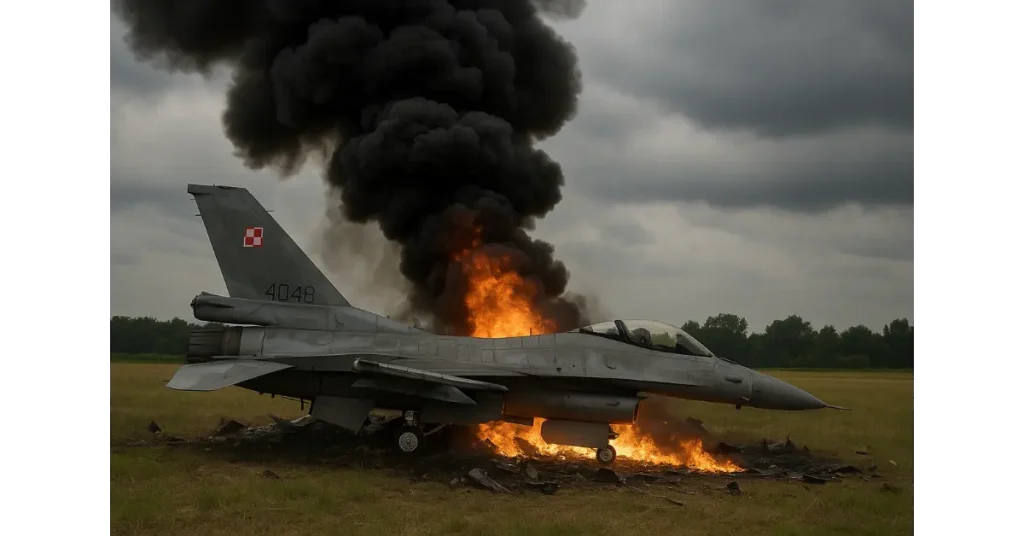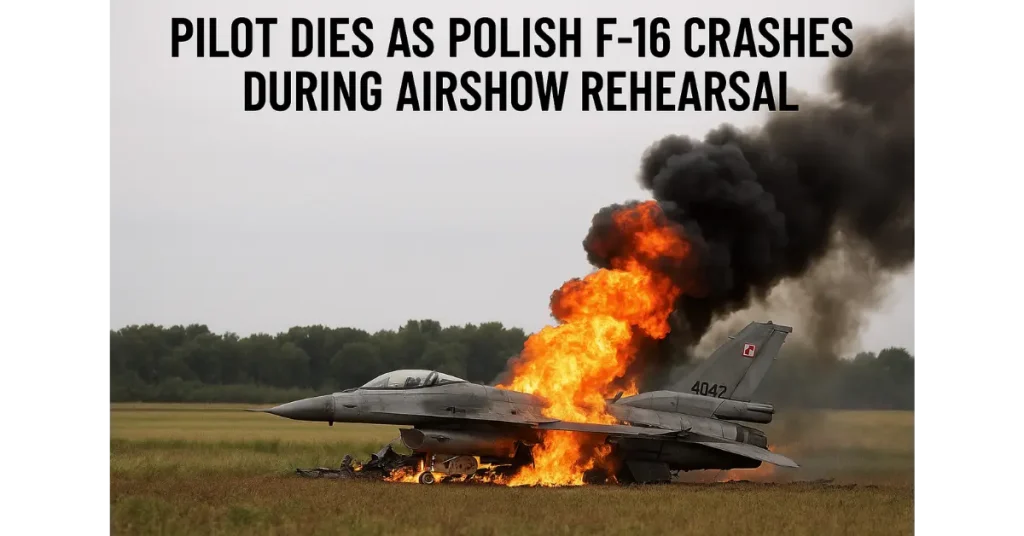Nothing prepares you for the crackle of flame and the sickening thud when a high-performance fighter jet spirals out of control. Yet that is exactly what unfolded on the afternoon of August 28, 2025, at Radom Airport in central Poland. A Polish Air Force F-16—one of the world’s most respected multirole combat aircraft—was executing a precision barrel roll rehearsal for the upcoming Radom Airshow when catastrophe struck. In an instant, the roar of the jet’s engine gave way to a plume of black smoke and a fuselage racing across the runway in flames. The pilot, a decorated officer known for his unwavering courage, paid the ultimate price.
In this comprehensive, human-focused report you will:
- Follow a detailed timeline of what happened at Radom.
- Explore the technical intricacies of a barrel roll and potential failure points.
- Understand how past airshow accidents have reshaped safety protocols.
- Consider two forward-looking perspectives on bolstering display flying safety.
- Reflect on the broader impact for military aviation and public confidence.
Our aim is to deliver clear, engaging insights that blend hard facts, expert context, and genuine human perspective—without jargon, fluff, or robotic phrasing. Let’s dive in.
What Happened at Radom: A Step-by-Step Account
Setting the Scene
Radom Airport sits roughly 100 kilometers south of Warsaw. Each year, hundreds of thousands of spectators flock to the Radom Airshow, drawn by the spectacle of aerobatic teams, historic warbirds, and modern fighters like the F-16. On August 28, 2025, Polish Air Force crews ran their final rehearsal, fine-tuning each maneuver to perfection.

Timeline of Events
- 5:15 pm GMT – Warm-Up Exercises
Pilots conducted a series of low-level passes and formation drills. Ground crews confirmed flight controls, hydraulics, and engine parameters were within operational norms. - 5:25 pm GMT – The Barrel Roll Sequence
The demonstration F-16 from the 31st Tactical Air Base near Poznań climbed to display altitude. The pilot tightened his harness, engaged the afterburner, and initiated the corkscrew loop. - 5:30 pm GMT – The Critical Moment
Video footage shows the jet invert at the barrel’s apex. Witnesses describe a sudden “lurch,” as if the aircraft hesitated mid-roll, then plummeted nose-first in a burst of flame. - 5:31 pm GMT – Crash and Rescue
The burning jet slid along the runway, shedding debris. Rescue teams reacted within seconds, battling flames and extracting the pilot’s remains. No ground personnel or spectators were injured. - Later That Evening – Public Announcement
Poland’s Defence Ministry confirmed the pilot’s death. Defence Minister Władysław Kosiniak-Kamysz, upon viewing the wreckage, honored the officer’s service, calling him courageous and dedicated. - Following Morning – Airshow Cancellation
Organizers and local authorities called off the entire weekend’s performances, citing respect for the fallen pilot and allowing time for investigation.
Anatomy of a Barrel Roll and Potential Failure Points
Understanding the dynamics of a barrel roll sheds light on why an elite pilot might lose control of a supersonic fighter jet.
The Physics Behind the Barrel Roll
A barrel roll combines a roll around the longitudinal axis with a loop in vertical plane. It demands precise coordination of thrust, control surfaces, and timing. The maneuver involves:
- Pitch-Up Entry: The pilot raises the nose by 15–20 degrees, increasing angle of attack.
- Roll and Loop Integration: Simultaneously, ailerons initiate a roll while the elevator maintains upward momentum.
- Inversion Point: At the apex, the jet is upside down and typically 1.1–1.5 G.
- Recovery: Smoothly returning to level flight at the same airspeed and altitude requires exact control inputs.
Where Things Can Go Wrong
Even small malfunctions or human factors can derail the maneuver:
- Hydraulic or Flight-Control Failure
F-16s rely on a fly-by-wire system. A glitch in hydraulic pressure or software could leave control surfaces unresponsive at a critical moment. - Engine Thrust Loss
A sudden flame-out during high-G maneuvers can drop airspeed below the stall threshold, rendering the jet unable to maintain lift. - Structural Fatigue
Repeated stress cycles from combat and training accumulate micro-cracks in airframe components, risking in-flight structural failure. - Spatial Disorientation
At speeds exceeding 300 knots and forces above 3 G, even veteran pilots can misinterpret their position relative to the horizon. - Environmental Factors
Crosswinds or gusty conditions on approach to inversion can disrupt the jet’s flight path during recovery.
Airshow Crashes—Learning from the Past
While tragic, airshow accidents have historically spurred vital safety reforms. Placing the Radom crash in this context highlights potential pathways to enhanced protection.
Significant Precedents
- Reno Air Races, 2011
A modified P-51 Mustang lost a wing, crashing into spectator areas and killing 11. Investigators pointed to insufficient maintenance under extreme racing modifications. - Shoreham Airshow, UK, 2015
A Hawker Hunter disintegrated on take-off, killing 11. The inquiry cited pilot error, overzealous low-level display, and limited spectator buffer zones. - Blue Angels, 2022
A US Navy F/A-18 Super Hornet clipped the runway edge in practice. While the pilot ejected safely, the incident led to revised minimum altitude rules for inverted rolls.
Evolving Safety Practices
- Buffer Zones
Increasing distance between performance areas and crowds to reduce risk from debris or errant aircraft. - Access to Real-Time Telemetry
Ground controllers now monitor key parameters—G-loads, speed, control inputs—to abort displays if anomalies appear. - Stringent Pre-Display Inspections
Mandating non-destructive testing (ultrasonic and X-ray) on critical wing and fuselage components before each show. - Altitude and Speed Limits
Restricting aerobatic sequences to flight envelopes with clear recovery margins, even for seasoned teams. - Enhanced Pilot Recency and Currency Checks
Requiring demonstration pilots to log dedicated display practice hours under supervision each month.
The Impact on Radom and the Aviation Community
Local and Economic Repercussions
Radom Airshow generated significant tourism revenue through:
- Hotel occupancy
- Local transport and dining
- Vendor stalls and sponsorships
Cancellation disrupts contracts, refunds hundreds of thousands of euros, and dampens regional business confidence.
Military Morale and Public Trust
For the Polish Air Force, this crash is a sobering reminder of the thin line between routine training and deadly risk. Families of service members share in the collective grief, while public audiences question whether airshows remain safe spectacles.
Two Paths Forward—Balancing Thrill and Safety
In the wake of this tragedy, stakeholders face a crossroads. Two natural-sounding approaches emerge.
Stricter Regulation and Oversight
Advocates for tighter rules propose:
- Independent Safety Boards: A civilian-military oversight panel to audit each display team.
- Flight Envelope Conservatism: Raising minimum safe altitudes by 20% for complex maneuvers.
- Mandatory Data Recorders: Installing cockpit voice and data recorders specifically for display sequences to accelerate investigations.
Technological Innovation
Others argue that smarter tools, not stiffer rules, offer the best promise:
- Autonomous Recovery Systems: AI-driven algorithms detect loss-of-control and momentarily override pilot inputs to stabilize the jet.
- Augmented Reality (AR) HUDs: Real-time overlay of trajectory vectors and stall margins, enabling split-second corrections.
- Advanced Composite Materials: Next-generation airframes that endure higher fatigue cycles with embedded health-monitoring sensors.
Frequently Asked Questions
Q1. How common are fighter jet crashes during airshows?
Though high-profile and dramatic, fighter jet crashes are extremely rare. Modern display teams prioritize safety, and airshow accident rates hover below 0.1 incidents per 100,000 flight hours.
Q2. What happens to the wreckage?
Military investigators secure the crash site, catalog parts, and remove debris for analysis. A detailed technical report takes months to complete.
Q3. Will the Radom Airshow return?
Organizers have indicated plans to resume the event in 2026, pending a comprehensive safety review. Spectators expect a renewed commitment to risk mitigation.
Conclusion
The Radom airshow crash of August 28, 2025, stands as a stark illustration of the perils inherent in high-performance aviation. As investigators sift through data and debris, the aviation community reflects on how to preserve the exhilaration of aerobatics while safeguarding pilots and spectators alike. Whether through tighter regulations or cutting-edge technology, the goal remains the same: honor the memory of a courageous pilot by making the skies as safe as possible. As fans await the return of airshows, they can take comfort in the relentless pursuit of lessons learned—and the promise of displays that inspire without sacrificing safety.


